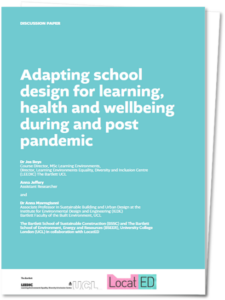14 March 2023
We have partnered with UCL The Bartlett on research exploring adapting school design for learning, health, and wellbeing
We are proud to have partnered with the UCL Institute for Environmental Design and Engineering’s new report, ‘Adapting school design for learning, health and wellbeing’, exploring how the school estate can play its part the address these issues.
 There is no doubt that the pandemic has adversely affected children’s mental health and wellbeing, often exacerbating existing difficulties – particularly in areas of deprivation.
There is no doubt that the pandemic has adversely affected children’s mental health and wellbeing, often exacerbating existing difficulties – particularly in areas of deprivation.
A study undertaken by the NHS in 2021 found that clinically significant mental health conditions amongst children had risen by 50% compared to three years earlier. A staggering 1 in 6 children were found to have a probable mental health condition. And according to research from the mental health charity, YoungMinds, 80% of young people with mental health needs agreed that the pandemic had made their mental health worse.
In 2021, the Children’s Commissioner published ‘The Big Ask: The Big Answer’, a report on the findings of a national consultation exercise with more than half a million children in England about their aspirations and worries for the future. This showed that 20% of children aged 9-17 were unhappy with their mental health, making wellbeing one of the top issues for children today.
“While this research and report with UCL predominantly looks at how school design can address these issues, at LocatED our focus is on finding opportunities through existing building use,” Lara Newman, our Chief Executive, comments. “Some schools, particularly those in London and other urban areas, have surplus space due to declining pupil numbers as a result of Brexit and the pandemic – for example, some London boroughs are predicting surplus pupil places at primary level of up to 20% by 2025.
“Working with the affected boroughs and the Department for Education, LocatED is keen to explore community-oriented, medium term meanwhile uses for these sites, including access to mental health support and community services for children and young people.
“This multi-agency use of existing education sites can help build a strong and resilient community wellbeing support network; ensure these vital public assets are not permanently lost from the education estate; and support young people’s mental health and wellbeing needs both now and in the future.”
Read the full report here.
